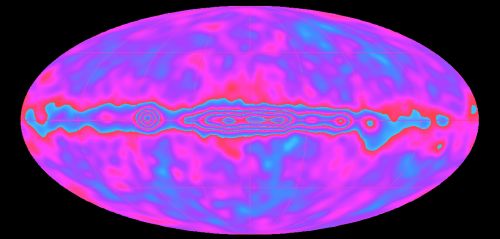Warm Fuzzy Glow
Has your brain stopped smoking from reading the last Big Bang message? It was very tricky.
Here is what we know now. The Big Bang wasn't an explosion of "stuff" in an empty Universe. It was an "explosion" of the very "fabric" of space and all the matter (mostly Hydrogen) in the Universe rode along on the expanding space.
Well, lets get this right. During the first few hundred thousand years of the Universe there wasn't any Hydrogen. There wasn't any because the Universe was way too hot for electrons to stay in orbit about a proton (that's what Hydrogen is; an electron in orbit about a proton). When you think about it, this makes sense. Heat is just the measure of how hard electrons, protons, neutrons, and atoms smack into each other. Since everything in the Universe was in this pretty small area, particle were really banging into each other. It was really crowded!
Remember how, way back when we were talking about burning alcohol on salt, we discussed how a photons, those little packets we call "light", are just electrons "talking" to other electrons? Well here at the Big Bang, electrons are packed really close together just like people at a rock concert. As the electrons bump into other particles they don't say "excuse me". Their conversation is more on the order of:
Hey! I just ran into something! Hey! I just ran into something else! Hey! Wow! I really banged into something there! and so on.
Electron conversations are important but sort of repetitious. Each time the electron bumps into another particle it emits a photon and, since there are so many photons and so many electron in such a small area, electrons are constantly absorbing and emitting photons. The photons couldn't travel more than a tiny distance before being absorbed. If you had been there (OK, you would have vaporized but imagine you could be there), you would have been blinded by light from everywhere but you couldn't see any distance at all. The Universe was glowing hot but opaque.
Finally, the Universe expanded big enough so that is was cool enough for electrons to latch onto protons and form Hydrogen atoms and, almost instantaneously, the Universe became transparent. Photons that just happened to be flying between electrons right then could go flying off into the new, transparent Universe. These escaped photons were the last ones from free electrons that were yelling "Hey! It's really hot here!". They were VERY high energy photons! They were what we would call ultra-violet, x-rays, and cosmic rays.
Remember that the Universe that these escaped photons are traveling through is expanding. That means that these photons are slowly, constantly red-shifting. The Big Bang Theory predicts that we should still be able to see these photons but they should be red-shifted way down into radio waves!
In 1962-63 Bell Telephone was trying to get the first commercially successful communications satellite, TELSTAR, up and working. They built a microwave antenna in Andover Maine as a "back up" antenna in case they didn't get the rest of the system up and running in time. Well, everything worked fine and this nifty new antenna wasn't needed for the satellite project so two astronomers, Arno Penzias and Robert Wilson, who worked for Bell decided to use the antenna to do some radio astronomy. It worked great except they had this constant, small electronic noise in the system. They knew it couldn't be from the sky since it didn't matter which direction they pointed the antenna. Penzias and Wilson tried everything they could think of to get rid of the noise. They even thought it might be from pigeon poop inside the antenna! They happen to mention their problem to another astronomer who had just read an article on the predicted Cosmic Background Radiation - those left over red-shifted photons from the Big Bang. Sure enough! Penzias and Wilson had discovered the Big Bang leftover photons. For this discovery they shared the 1978 Nobel Prize for Physics (there is no Nobel Prize for Astronomy!). Good thing it wasn't pigeon poop!

This just in -- John Mather of the NASA Goddard Space Flight Center in Greenbelt, MD and George Smoot of the Lawrence Berkeley National Laboration in Berkeley, CA, have just won the 2006 Nobel Prize in Physics. Read more about it at Nobel Prize in Physics for confirming the Big Bang.